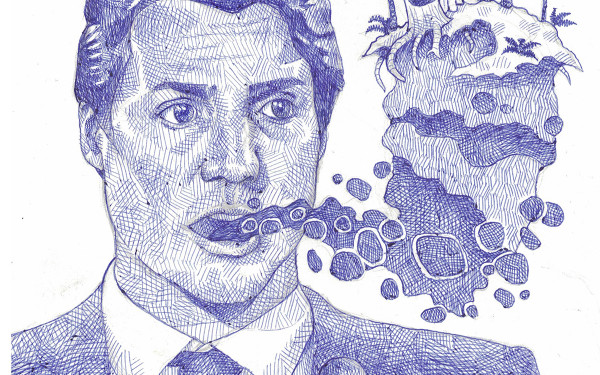It’s On Us to Fight Climate Change
Citizens Must Come Together and Rally for Progress
For many, wrapping our heads around the severity of climate change is not easy. The threat it poses is unlike other threats to human life.
It does not have the same sense of urgency as a military invasion. It does not carry the same kind of explosive intensity as a plane being flown into the side of a building. The nature of the climate threat is different. Its changes are small and imperceptible; they occur at a much slower pace. They often involve single-digit changes in temperature and ice melting at glacial speed.
Another barrier to understanding climate change is the sheer enormity of its scale. After all, it encompasses the entire earth. For these reasons, taking on climate change can feel like fighting an impossibly large enemy that you cannot even see.
But just because something is hard to see does not make it any less real. In 2014, the American Association for the Advancement of Science released a report that indicated that 97 per cent of climate scientists have agreed upon the very real threat of human-caused climate change. “This agreement is documented not just by a single study,” said that report, “but by a converging stream of evidence over the past two decades from surveys of scientists, content analyses of peer-review studies, and public statements issued by virtually every membership organization expert in the field.”
Over the last few centuries, we have released so many fossil fuels into the atmosphere that it now contains 42 per cent more carbon dioxide than it did during the pre-industrial period. The increased presence of carbon dioxide and other greenhouse gasses in our atmosphere has transformed it into what has been described as a large, heat-trapping blanket.
Although climate change is a cumulative problem whose impact is best observed over time, the consequences of tipping the atmospheric balance have begun to reveal themselves.
The combustion of fossil fuels comes primarily from three sectors: electricity, transportation, and industry. In 2011, they were in large part responsible for the 33.2 billion tonnes of carbon dioxide emissions that we pumped into the atmosphere. According to most atmospheric scientists, if we do not radically change the structure of our economy such that emissions are significantly reduced, it will have unquestionably perilous consequences.
In 2009 at the U.N climate summit in Copenhagen, the major polluting governments signed a non-binding agreement which pledged to prevent temperatures from rising more than 2 degrees Celsius above pre-industrial global temperature. This limit represents the generally-accepted ‘safe’ limit, beyond which an existential threat to the species would be imminent. However, at the rate we are going, the hope that we will attain such a target is proving dim.
In 2012, the World Bank released a report stating that we are headed for a world that, by the end of the century, will be four degrees Celsius warmer than it was when the report was published. The article warned that we have “extreme heat waves, declining global food stocks, loss of ecosystems and biodiversity, and life-threatening sea level rise” in store in the near future. “There is also no certainty,” said the report, “that adaptation to a four degree Celsius world is possible.” Put differently, things for the species do not look good. And if we continue with our current rates of consumption, things will get much, much worse.
In one sense, the situation seemed to improve in April of 2016 when around 190 countries came together to sign the Paris Agreement. Although the agreement was non-binding, it expressed the commitment of many nations to take steps to reduce greenhouse gas emissions in order to offset global warming. The agreement was a major step in consensus-building grounded in the view that climate change was a global threat that needed to be taken seriously. Unfortunately, the Trump administration has recently backed out of the agreement, sending a tremor of shock and concern across the globe.
Indeed, an administration that seems to be built on the mantra ‘America First, Humanity Second’ is not something to be taken lightly. The American government risks sending a dangerous message to that climate change—or simply the rest of the world—doesn’t matter. And even more worrying, the insinuation that the threat is not real.
But the U.S. is not the only country that has decided global warming is ‘someone else’s problem.’ Even after signing the Paris Agreement, Trudeau returned to Canada only to sign off on two more pipelines. Further, in January 2017, when Trump gave new life to the Keystone pipeline, Trudeau cheered enthusiastically. To be sure, Canadians still have some work to do.
Collective action has to be taken to dramatically change the structure of our economy and the way we live.
However, it will take more than the isolated actions of individuals. The situation that we have gotten ourselves into is not the kind that can be solved simply by remembering to turn off the kitchen light. Collective action has to be taken to dramatically change the structure of our economy and the way we live. That will require the work of concerned citizens who mobilize themselves to remind the government of the threat of global warming when, for one indefensible reason or another, their memory gets a little hazy.
We have to demand the kinds of policies that encourage divestment from fossil fuel industries, placing strict emissions targets on corporations and industrial facilities, incentives for local production of goods, as well as the gradual switching over from fossil fuels such as coal, oil, and natural gas to renewable energy sources such as solar, wind and air.
These last few years, continent-wide protests in response to the Keystone XL and Dakota Access pipelines have been powerful and inspiring examples of what is possible when enough people get together to say “enough is enough.”
During the Obama administration, native and non-native opponents of the Dakota access pipeline were, after a violent and protracted struggle, able to get Obama to reroute the pipeline. The pipeline, which was set to run under the Missouri River, would have also run the constant risk of oil spills in what is the only source of water for the surrounding community, the Standing Rock Sioux.
The pipeline ignited massive resistance from the Standing Rock Sioux tribe and the protests drew support from hundreds of other tribes from across the Americas. In fact, earlier in June, the tribe won a significant legal battle in an American federal court leading to a potential shut-down of the pipeline. Although Trump recently signed a memo to give the pipeline a speedy greenlight, pressure from the community lead a federal judge to rule that the administration conducted an inadequate environmental review of the potential impact of oil spills on fishing and hunting rights as well as on environmental justice.
It is true, however, that with our current market logic, many politicians and members of the business class fail to see our environment as a vital resource for human existence. Speaking at a rally earlier in June, Trump indicated—without a trace of irony—that signing the memo for the $3.8 billion project was a no-brainer.
“I just closed my eyes and said ‘Do it,’” said the President.
If it is the case that when our political elites look at, say, the Canadian boreal forests and can only see an unwelcome obstacle to the semi-solid bitumen in Alberta tar sands, then something is wrong. It is important, even necessary, that we not only looking for ways to protect our environment in the present, but also ways to lessen that impact in the future.
This is not always easy when as consumers we are beholden to an economic and social culture that is constantly telling us to speed up, precisely when we need to slow down. The point I’m getting at is that in addition to the necessary political pressure to redirect public dollars away from fossil fuels and toward subsidizing a green economy, we will have to start thinking differently—very differently—so that those changes in policy are possible at all.

_600_832_s.png)

_600_375_90_s_c1.jpg)
WebEdit__600_375_90_s_c1.jpg)

